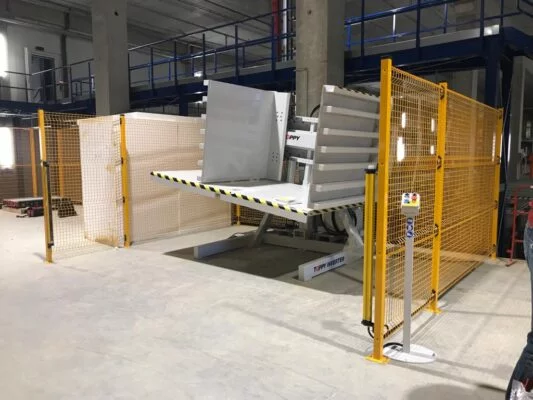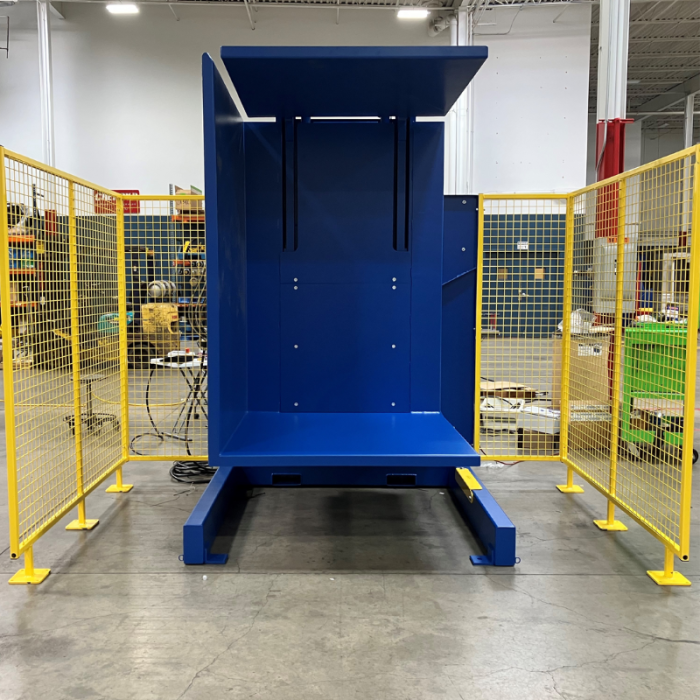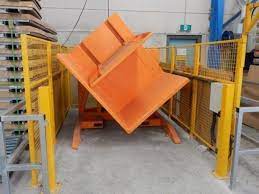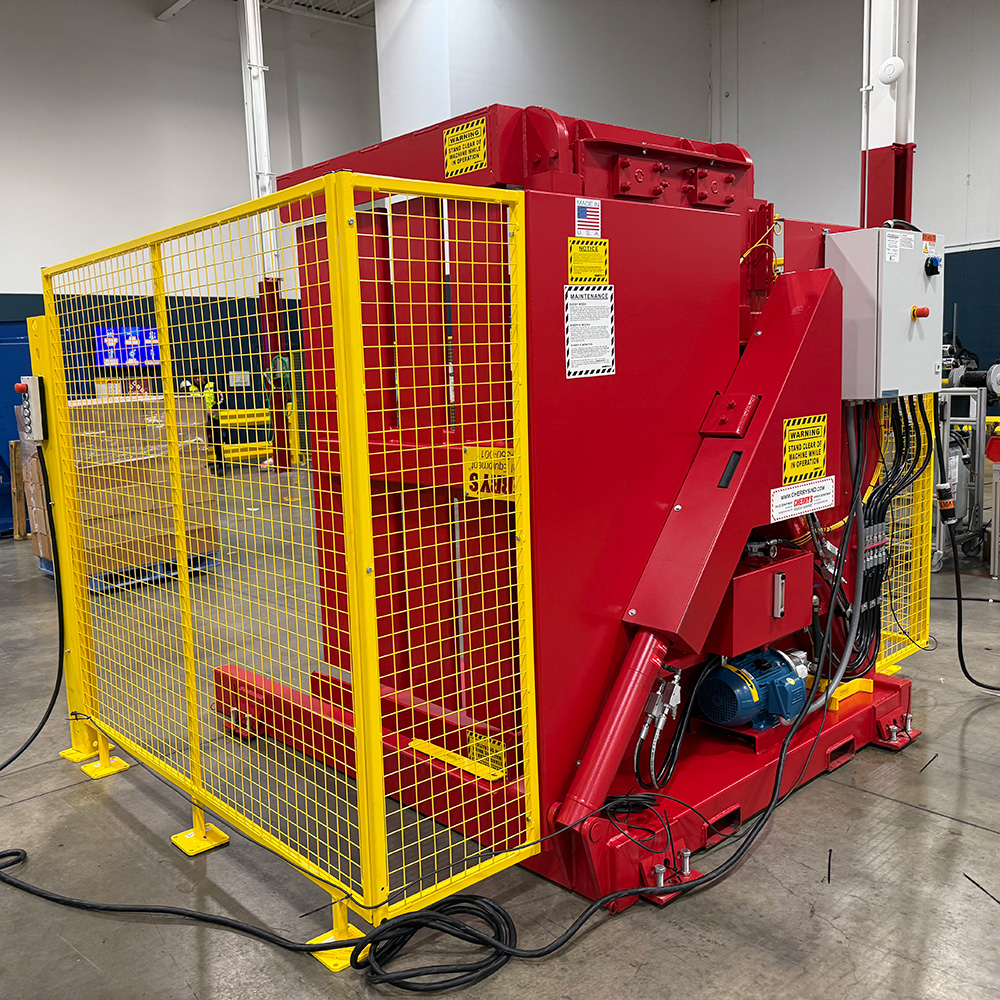Pallet Inverter: How to Improve Operator Ergonomics in Furniture Plants?
Your team is the backbone of your furniture plant, but they are often tasked with manually handling heavy, awkward loads. Every day, they lift stacks of MDF panels, flip bulky components, and move finished goods, putting immense strain on their backs, shoulders, and wrists. You've probably seen the fatigue and heard the complaints about aches and pains. This isn't just uncomfortable; it's a direct threat to your operation, leading to costly worker compensation claims, high employee turnover, and frustrating production bottlenecks that hurt your bottom line. What if there was a straightforward mechanical solution that could virtually eliminate the most dangerous physical tasks and, in turn, boost your plant's overall efficiency?
A pallet inverter improves operator ergonomics in furniture plants by mechanizing the entire process of lifting and rotating heavy loads. Instead of workers manually bending, lifting, and twisting, the machine securely clamps and turns the pallet 180 degrees. This allows operators to access items at a comfortable, waist-level working height, effectively eliminating the physical strain that causes most workplace injuries in the industry.

This simple-sounding solution has profound impacts on your daily operations. It’s not just about meeting safety standards; it’s about fundamentally changing the nature of work on your factory floor for the better. The benefits extend far beyond just preventing injuries. By making tasks easier and faster, you unlock new levels of productivity and quality. Let's dig deeper into the specific risks your team faces and see exactly how a pallet inverter provides a comprehensive solution.
What are the specific ergonomic risks in furniture manufacturing?
You see your operators working hard every day, but do you know the specific, medically-defined risks they face when handling heavy furniture components? These aren't just minor aches; they are cumulative traumas that can lead to chronic pain and long-term disability. Ignoring these underlying risks is like ignoring a slow leak in your factory's foundation—eventually, the damage becomes severe and expensive to fix. The first step to creating a safer and more productive environment is to clearly identify these ergonomic hazards.
The most significant ergonomic risks in furniture manufacturing stem from repetitive manual material handling. These tasks involve forceful exertions in awkward postures, such as lifting heavy wood panels from a low pallet, twisting while carrying an assembled chair, or reaching overhead to stack boxes. These movements, when repeated hundreds of times a day, lead directly to musculoskeletal disorders (MSDs).

To really understand the impact, we need to break down these general risks into specific problems that plague furniture plants. I’ve visited countless facilities over the years, and the same issues appear time and again. It’s a pattern of physical stress that is unfortunately built into traditional production workflows. But recognizing the pattern is the key to breaking it.
The Three Main Culprits of Injury
The physical demands in a furniture factory can be broken down into three main categories of risk. Each one contributes to worker fatigue and potential injury in its own way.
-
High Force Exertions: This is the most obvious risk. Furniture materials are heavy. A single sheet of ¾-inch MDF can weigh nearly 100 pounds (about 45 kg). An assembled wooden dresser or a sofa frame requires immense physical strength to move. When your operators have to lift, push, or pull these items manually, their muscles and spinal discs are put under tremendous stress. This isn't just about the single heaviest item; it's the cumulative effect of lifting moderate-to-heavy items all day long.
-
Awkward Postures: This is a more subtle, but equally dangerous, risk. An operator bending down to pick up the last few panels from a pallet is putting their lumbar spine in a very vulnerable position. Reaching high above the shoulders to stack a finished product can lead to rotator cuff injuries. Twisting the torso while holding a heavy load is one of the most common causes of herniated discs. These non-neutral postures multiply the force exerted on the body, making even a relatively light object feel much heavier and more dangerous to handle.
-
Repetitive Motions: The third risk factor is repetition. The human body is not designed to perform the exact same motion over and over for eight hours a day. In furniture manufacturing, tasks like loading a CNC machine, assembling components, or packing boxes are highly repetitive. This can lead to repetitive strain injuries (RSIs) like tendonitis or carpal tunnel syndrome, even if the force involved in a single motion is low.
This table shows how these risks manifest in common factory tasks.
| Common Manual Task | Primary Ergonomic Risks | Potential Injuries |
|---|---|---|
| Unstacking panels from a pallet | Awkward Posture (bending), High Force | Lower back strain, herniated disc |
| Manually flipping a large tabletop | Awkward Posture (twisting), High Force | Spinal injury, shoulder strain |
| Stacking finished goods | Awkward Posture (reaching), Repetition | Rotator cuff tear, shoulder impingement |
| Assembling components at a fixed bench | Repetitive Motion, Awkward Posture | Tendonitis, carpal tunnel syndrome |
Understanding these specific risks is crucial. They are not just abstract safety concepts; they are daily realities for your workers and hidden costs for your business.
How does a pallet inverter directly reduce physical strain?
You see the problem: manual handling is straining your team. But how, exactly, does a piece of machinery solve a human-scale problem like back pain? It's easy to think of equipment as just another complex system to manage, but the right machine doesn't add complexity—it removes it. A pallet inverter's genius is its simplicity. It redesigns the most strenuous tasks to fit the natural, safe capabilities of the human body, rather than forcing the body to conform to an inefficient and dangerous process.
A pallet inverter directly reduces physical strain by completely removing the need for operators to lift, bend, or twist with a heavy load. It takes the most hazardous part of the job—inverting a stack of goods—and automates it. By clamping the load and rotating it 180 degrees, the machine allows operators to always work at an optimal, ergonomic height. This simple mechanical action eliminates the root causes of most handling-related injuries.

The real magic happens when you see how this changes the workflow. An operator who used to spend their day bent over a pallet is now standing upright. A task that required two or three people can now be done safely by one. Let’s break down the specific ways a pallet inverter transforms the physical demands of the job.
From Strenuous Labor to Simple Supervision
A pallet inverter introduces a fundamental shift in the operator's role, from manual laborer to machine supervisor. This shift has profound ergonomic benefits.
Eliminating Bending with "Top-Down" Access
Think about unloading a standard pallet of furniture panels. The operator starts at a comfortable height, but as the stack gets lower, they have to bend further and further. The last few layers are the most dangerous, requiring deep bending from the waist while lifting a heavy object. A pallet inverter solves this completely. When the stack is halfway depleted, the operator can place an empty pallet on top, invert the entire load, and remove the original pallet. Suddenly, the items that were at the bottom are now on top, at a perfect working height. This process can be repeated as needed, ensuring the operator never has to bend down.
The "Golden Zone" of Work
Ergonomics experts talk about a "power zone" or "golden zone" for lifting, which is the area between the worker's mid-thigh and mid-chest. Work performed within this zone requires less effort and puts significantly less stress on the body. A pallet inverter is designed to keep all manual tasks within this zone.
| Action | Manual Method | With Pallet Inverter |
|---|---|---|
| Accessing Bottom Items | Operator bends to floor level | Load is inverted; items are at waist level |
| Lifting Force | Full weight of the product | Minimal; operator slides items, not lifts |
| Body Posture | Constant bending, reaching, twisting | Neutral, upright posture |
| Physical Demand | High and variable | Low and consistent |
Reducing Forceful Exertions to Zero
The most dangerous part of handling furniture components is the combination of weight and posture. A pallet inverter removes the weight from the equation. The machine's hydraulic or electric system does 100% of the lifting and rotating. The operator's job changes from a high-force task (lifting a 70lb panel) to a low-force task (pushing a button and then sliding the panel off the stack). This dramatic reduction in force exertion is the single biggest factor in preventing acute injuries like muscle tears and chronic conditions like degenerative disc disease. The strain on the operator's spine, shoulders, and arms is virtually eliminated.
Beyond ergonomics, what are the other operational benefits?
Improving worker safety is a powerful motivator, but as a business owner, I know you need to justify every equipment purchase with a clear return on investment. You're responsible for the overall health of the company, and that means every decision must contribute to the bottom line. It's easy to view an ergonomic solution as just a "cost of compliance," but this is a limited perspective. I’ve learned that focusing only on safety means you’re missing out on the massive operational and financial gains that come as a direct result.
Beyond improving ergonomics, a pallet inverter acts as a catalyst for wider operational excellence. It dramatically increases process speed, reduces costly product damage, streamlines logistics by simplifying pallet exchange, and improves overall quality control. These benefits translate directly into higher throughput, lower operating costs, and a stronger, more resilient production line.

When I was building my own business, SHJLPACK, I quickly realized that the smartest investments were the ones that solved multiple problems at once. A pallet inverter is a perfect example of this. It's not just a safety device; it's a productivity machine. Let's look at the tangible, bottom-line benefits you can expect.
A Multi-Tool for Plant Efficiency
A pallet inverter is more than a one-trick pony. It provides solutions to several common operational headaches in a busy furniture plant.
1. Drastically Increased Throughput
Compare the manual process of flipping a pallet to using an inverter. Manually, two workers might spend 10-15 minutes carefully unstacking, moving, and restacking the entire load. It's slow, labor-intensive, and a bottleneck. A pallet inverter can be operated by a single worker and completes the same task in about 60-90 seconds. This is a massive time saving. When you need to retrieve a damaged box from the bottom of a stack or switch from an in-house pallet to a shipping pallet, this speed translates directly into higher overall throughput for your entire line.
2. Significant Reduction in Product Damage
Manual handling is risky for products, especially finished furniture with delicate surfaces, veneers, or paint. Every time a heavy item is lifted and moved by hand, there's a chance it will be dropped, scraped, or bumped. Corners get dented, and finishes get scratched. This damage leads to costly rework or scrap. A pallet inverter handles the entire load with secure, adjustable clamping pressure. It moves the product smoothly and gently, minimizing the risk of damage. I’ve seen clients cut their handling-related damage costs by over 50% after implementing an inverter.
3. Streamlined Pallet Management
Many plants use high-quality, expensive pallets for internal use and cheaper, one-way pallets for shipping. Manually transferring a full load from one to the other is a slow, tedious task. A pallet inverter makes this process effortless. You simply place the shipping pallet on top of the load, invert it, and remove the expensive in-house pallet for reuse. This not only saves labor but also reduces your spending on shipping pallets and protects your valuable pallet assets.
Here’s a clear breakdown of the financial impact:
| Operational Benefit | Direct Impact | Financial Gain |
|---|---|---|
| Faster Cycle Time | More pallets processed per hour | Increased production capacity without adding staff |
| Less Product Damage | Lower rates of scrap and rework | Reduced material and labor waste; higher profit margin |
| Efficient Pallet Exchange | Faster outbound logistics; protection of assets | Lower shipping supply costs; reduced pallet replacement costs |
| Improved QC Access | Ability to inspect bottom layers easily | Fewer defective products shipped; lower customer return rates |
These benefits compound. Faster processing with less damage and lower supply costs makes your entire operation more lean, agile, and profitable.
How do you choose the right pallet inverter for a furniture plant?
You're convinced that a pallet inverter is the right move for your plant. You see the potential for improved safety and efficiency. But now you're looking at the options—different models, sizes, and features—and it can feel overwhelming. I understand this completely. Making the wrong choice can lead to a machine that doesn't fit your workflow, disrupts your floor plan, or worse, doesn't handle your products safely. The key is to approach the decision systematically, based on your specific operational needs.
To choose the right pallet inverter for a furniture plant, you must first carefully evaluate four critical factors: the maximum weight and dimensions of your palletized loads, the volume or throughput you need to handle, your available factory floor space, and the specific characteristics of your products, such as their fragility, which will determine the need for features like adjustable clamping pressure.

As an engineer who has designed and built packing machinery, I always start with the product and the process. The machine must serve them, not the other way around. Let's walk through the decision-making process step-by-step to ensure you select a machine that becomes a seamless part of your operation.
A Practical Guide to Selecting Your Machine
Answering these questions will guide you directly to the right model for your needs.
1. What Are You Handling? (Load Specification)
This is the most important question. You need to know the specifics of your heaviest, widest, and tallest pallet loads. Don't guess. Measure and weigh your typical and your extreme loads.
- Weight: What is the maximum weight? This determines the required lifting capacity of the inverter.
- Dimensions: What is the pallet footprint (e.g., 48"x40") and the maximum height of the stacked load? This defines the size of the inverter's "loading window."
- Load Type: Are you handling solid stacks of panels, boxes of flat-pack furniture, or irregularly shaped assembled items? This will influence the type of clamping system you need.
2. How Will You Load It? (Loading Method)
This determines the machine's design and how it integrates with your existing equipment.
- Forklift-Loaded: If you use forklifts, a standard model with raised tables is efficient. The forklift places the pallet directly into the machine.
- Pallet Jack-Loaded: If you use manual or electric pallet jacks, you need a machine that can be loaded at ground level. These models either have a loading ramp or tables that lower all the way to the floor. This is a critical consideration for flexibility and accessibility.
3. How Fragile Is Your Product? (Clamping Pressure)
This is non-negotiable for the furniture industry. Standard inverters might use a fixed, high clamping pressure designed for durable goods like bags of cement. This would crush a stack of veneered panels or boxed furniture. You need a machine with adjustable clamping pressure. This allows your operator to set a gentle but firm pressure that secures the load without causing any damage. Always ask a potential supplier about their pressure control system.
4. What Does Your Space Allow? (Footprint and Layout)
Finally, consider the physical reality of your plant floor.
- Footprint: Pallet inverters come in various sizes. Measure your available space and ensure you account for operational clearance around the machine for loading, unloading, and maintenance.
- Workflow Integration: Where will the inverter provide the most value? Near the receiving dock for inspecting incoming goods? On the production line for feeding machines? Or in the shipping area for swapping to shipping pallets? The ideal location will influence the model you choose.
| Key Consideration | Question for Your Team | Why It's Critical for Furniture |
|---|---|---|
| Load Capacity | What is our heaviest and largest pallet load? | Prevents buying an undersized machine; ensures safety. |
| Product Fragility | How easily can our products be crushed or damaged? | Mandates adjustable clamping pressure to protect goods. |
| Loading Equipment | Do we use forklifts, pallet jacks, or both? | Determines if you need a ground-level or raised-table model. |
| Throughput Needs | How many pallets per day need handling? | Guides the choice between a simple standalone unit or a more automated system. |
By carefully considering these four areas, you move from simply buying a machine to strategically investing in a solution that is perfectly tailored to your furniture plant's unique challenges.
My Take: Why Overlooking Ergonomics Is a Critical Business Mistake
Over the years, I’ve talked to hundreds of factory owners and managers. Many of them see ergonomics as a "soft" issue, something for the HR department or a box to tick on a safety audit. I understand the pressure to focus on production numbers and hard costs. But I've seen firsthand how this mindset can backfire, leading to disasters that are anything but soft. A star employee out on long-term disability, a key production line crippled by absences, skyrocketing insurance premiums—these are hard financial realities.
From my experience evolving from a machine engineer on the floor to founding SHJLPACK, I can tell you with certainty: overlooking ergonomics is one of the most critical business mistakes you can make. It's a failure to protect your most valuable asset—your people. The hidden, long-term costs of injuries, low morale, and high employee turnover will always outweigh the upfront investment in smart, ergonomic equipment like a pallet inverter.
When I started my career as an engineer, working on the factory floor, I wasn't just designing machines; I was living the process. I felt the physical strain of handling heavy parts day in and day out. I saw talented colleagues—good, hardworking people—slow down, develop chronic pain, and sometimes leave the industry altogether because their bodies just couldn't take the abuse anymore. That experience stuck with me.
When I had the opportunity to build my own company, SHJLPACK, I made a promise to myself. I knew that creating a safe work environment wasn't just the right thing to do; it was the only way to build a successful, sustainable, and profitable business. Your best people are your biggest competitive advantage. They have the experience, the skill, and the knowledge that you can't easily replace. Why would you risk losing them to a preventable injury?
I often think of a client I admire, a steel mill owner named Javier Morales. He is pragmatic and data-driven, analyzing every investment for its return. He would never spend money on something that didn't improve his operation. Yet, he has invested heavily in automation and process improvements that make work safer and easier for his team. He understands that a business is a system, and the human element is the most critical component. An investment that reduces downtime, cuts insurance costs, boosts morale, and increases throughput by keeping your best people healthy and on the job isn't a cost—it's one of the highest-ROI investments you can make.
A pallet inverter is not just a piece of steel. It's a statement about your company's values. It tells your team that you value their health and well-being. And a worker who feels valued is a worker who is more engaged, more focused on quality, and more committed to your company's success. That's not a soft benefit. That's a hard, strategic advantage.
Conclusion
Improving ergonomics with a pallet inverter is not just about safety. It's a strategic investment that boosts productivity, reduces costs, and protects your most important asset—your team.




